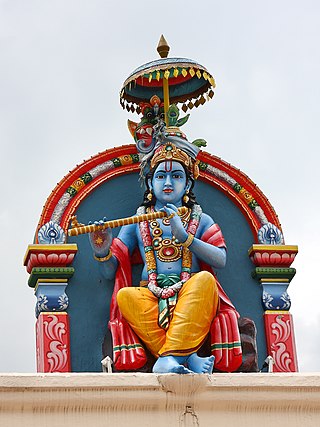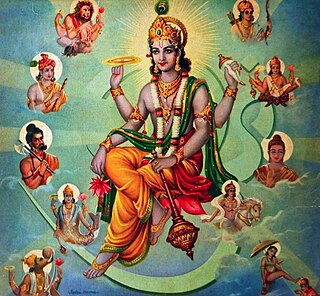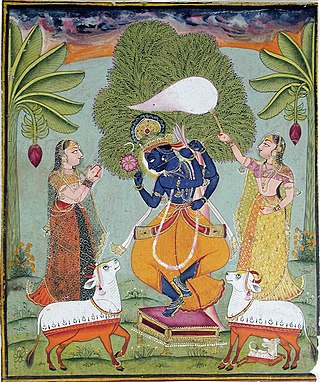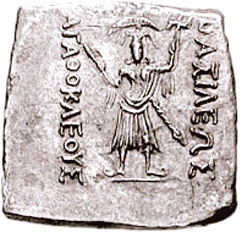
Krishna is a major deity in Hinduism. He is worshipped as the eighth avatar of Vishnu and also as the Supreme God in his own right. He is the god of protection, compassion, tenderness, and love; and is one of the most popular and widely revered among Hindu divinities. Krishna's birthday is celebrated every year by Hindus on Krishna Janmashtami according to the lunisolar Hindu calendar, which falls in late August or early September of the Gregorian calendar.

Avatar is a concept within Hinduism that in Sanskrit literally means "descent". It signifies the material appearance or incarnation of a powerful deity, or spirit on Earth. The relative verb to "alight, to make one's appearance" is sometimes used to refer to any guru or revered human being.

The Heliodorus pillar is a stone column that was erected around 113 BCE in central India in Besnagar. The pillar was called the Garuda-standard by Heliodorus, referring to the deity Garuda. The pillar is commonly named after Heliodorus, who was an ambassador of the Indo-Greek king Antialcidas from Taxila, and was sent to the Indian ruler Bhagabhadra. A dedication written in Brahmi script was inscribed on the pillar, venerating Vāsudeva (krishna), the Deva deva the "God of Gods" and the Supreme Deity. The pillar also glorifies the Indian ruler as "Bhagabhadra the savior". The pillar is a stambha which symbolizes joining earth, space and heaven, and is thought to connote the "cosmic axis" and express the cosmic totality of the Deity.

Mahavishnutransl. 'Great Vishnu' is an aspect of Vishnu, the principal deity in Vaishnavism. In his capacity as Mahavishnu, the deity is known as the Supreme Purusha, the absolute protector and sustainer of the universe, the one who is beyond human comprehension, and all attributes.
The word Bhagavan, also spelt as Bhagwan, an epithet within Indian religions used to denote figures of religious worship. In Hinduism it is used to signify a deity or an avatar, particularly for Krishna and Vishnu in Vaishnavism, Shiva in Shaivism and Durga or Adi Shakti in Shaktism. In Jainism the term refers to the Tirthankaras, and in Buddhism to the Buddha.

Historical Vishnuism as early worship of the deity Vishnu is one of the historical components, branches or origins of the contemporary and early Vaishnavism, which was subject of considerable study, and often showing that Vishnuism is a distinctive worship — a sect. The tradition was forming in the context of Puranic Vaisnavism evolving in the process of revitalizing religion of Brahmanism, of which Vishnuism is believed to be a part, through assimilating a number of orthodox, non-conformist and tribal elements; the absorption of mother goddess worship, into what now known a Vaishnava sampradayas. It is a tradition of the historical Vedic religion and is distinguished from other historic schools later forming the Vaishnavism by its primary worship of Vishnu, later identified as the source of all Avatars. A number of separate sects or traditions merged with each representing the names of god of Vaishnavism. In contemporary Vaishnavism God is also known as Narayana, Vasudeva and Krishna and behind each of those names is a divine figure with attributed supremacy in Vaishnavism, that relates to historic traditions that some scholars theorize to be separate and distinct historically. It is distinct from Krishnaism, as in the revival of Bhakti, found in the Bhagavata it is referred as Vishnuism.

Pancharatra was a religious movement in Hinduism that originated in late 3rd-century BCE around the ideas of Narayana and the various avatars of Vishnu as their central deities. The movement later merged with the ancient Bhagavata tradition and contributed to the development of Vaishnavism. The Pancharatra movement created numerous literary treatises in Sanskrit called the Pancharatra Samhitas, and these have been influential Agamic texts within the theistic Vaishnava movements.

Jiva Goswami was an Indian philosopher and saint from the Gaudiya Vaishnava school of Vedanta tradition, producing a great number of philosophical works on the theology and practice of Bhakti yoga, Vaishnava Vedanta and associated disciplines. He is known as one of the Six Goswamis of Vrindavan and was the nephew of the two leading figures, Rupa Goswami and Sanatana Goswami.

In Hinduism, the concept of God varies in its diverse religio-philosophical traditions. Hinduism comprises a wide range of beliefs about God and divinity, such as henotheism, monotheism, polytheism, panentheism, pantheism, pandeism, monism, agnosticism, atheism, and nontheism.

Radha-Krishna is the combined form of the Hindu god Krishna with his chief consort and shakti Radha. They are regarded as the feminine as well as the masculine realities of God, in several Krishnaite traditions of Vaishnavism.

Ekasarana Dharma is a neo-Vaishnavite monolithic sect propagated by Srimanta Sankardeva in the 15th-16th century in the Indian state of Assam. It reduced focus on Vedic ritualism and focuses on devotion (bhakti) to Krishna in the form of congregational listening (shravan) and singing his name and deeds (kirtan).

Vaishnavism is one of the major Hindu denominations along with Shaivism, Shaktism, and Smartism. It is also called Vishnuism since it considers Vishnu as the sole supreme being leading all other Hindu deities, that is, Mahavishnu. Its followers are called Vaishnavites or Vaishnavas, and it includes sub-sects like Krishnaism and Ramaism, which consider Krishna and Rama as the supreme beings respectively. According to a 2010 estimate by Johnson and Grim, Vaishnavism is the largest Hindu sect, constituting about 641 million or 67.6% of Hindus.

Krishnaism is a term used in scholarly circles to describe large group of independent Hindu traditions—sampradayas related to Vaishnavism—that center on the devotion to Krishna as Svayam Bhagavan, Ishvara, Para Brahman, who is the source of all reality, not an avatar of Vishnu. This is its difference from such Vaishnavite groupings as Sri Vaishnavism, Sadh Vaishnavism, Ramaism, Radhaism, Sitaism etc. There is also a personal Krishnaism, that is devotion to Krishna outside of any tradition and community, as in the case of the saint-poet Meera Bai. Leading scholars do not define Krishnaism as a suborder or offshoot of Vaishnavism, considering it at least a parallel and no less ancient current of Hinduism.
Svayam Bhagavan is a Sanskrit concept in Hinduism, referring to the absolute representation of Bhagavan as a singular deity in a monotheistic framework. The concept is most commonly associated with a male deity, for instance in Hindu sub-movements like Krishnaism and Gaudiya Vaishnavism, in which Krishna is regarded as Svayam Bhagavan.

The Dashavatara are the ten primary avatars of Vishnu, a principal Hindu god. Vishnu is said to descend in the form of an avatar to restore cosmic order. The word Dashavatara derives from daśa, meaning "ten", and avatāra, roughly equivalent to "incarnation".

Vāsudeva, later incorporated as Vāsudeva-Krishna, Krishna-Vāsudeva or simply Krishna, was the son of Vasudeva Anakadundubhi, king of the Vrishnis in the region of Mathura. He was a leading member of the Vrishni heroes, and may well have been an historical ruler in the region of Mathura.

Gopala Krishna refers to a form of the Hindu deity Krishna, as featured in the Harivamsha and the Puranas. The narratives of Gopala Krishna are set in the cowherd settlement of the Vraja region called Gokulam, where he is raised by his foster-parents, Nanda and Yashoda.

Vishnu, also known as Narayana and Hari, is one of the principal deities of Hinduism. He is the supreme being within Vaishnavism, one of the major traditions within contemporary Hinduism.
Sat Sandarbhas is a 16th-century Vaishnava Sanskrit text, authored by Gaudiya Vaishnava theologian Jiva Goswami. The six treatise are Tattva-, Bhagavat-, Paramatma-, Krishna-, Bhakti-, and Priti-sandarbha. Jiva's Krama-sandarbha commentary on the Bhagavata Purana is often described as the "seventh" of the six sandarbhas.

Saṃkarṣaṇa later known as Balarama, was a son of Vasudeva Anakadundubhi, king of the Vrishnis in the region of Mathura. He was a leading member of the Vrishni heroes, and may well have been an ancient historical ruler in the region of Mathura. The cult of Saṃkarṣaṇa with that of Vāsudeva is historically one of the earliest forms of personal deity worship in India, attested from around the 4th century BCE.
















